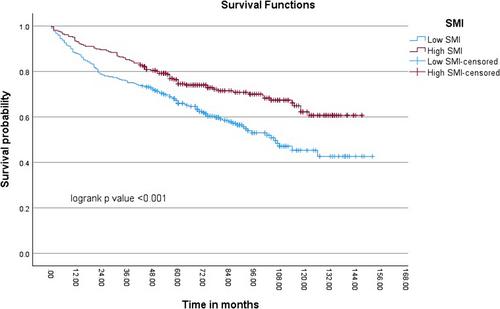Muscle matters: Skeletal muscle index and body mass index impact on complications and survival in renal cancer
Abstract
Objective
The objective of this study is to independently assess skeletal muscle index (SMI) and body mass index (BMI) as prognostic determinants for renal cell carcinoma (RCC) and investigate their correlation with surgical outcomes.
Patients and methods
A retrospective cohort study of 524 RCC patients diagnosed between August 2010 and July 2018 was conducted using data from the Zealand University Hospital Renal Cancer Database in Denmark. Patient information was extracted from electronic patient records and the National Cancer Registry and encompassed demographics, clinical factors, tumour characteristics and surgical details. SMI was calculated from a single third lumbar vertebra (L3) axial computed tomography (CT) image via CoreSlicer software and classified into high using gender-specific thresholds. Primary outcomes focused on complications within 90 days as well as survival outcomes, and their relation with both SMI and BMI. Multivariable analysis assessed SMI's independent prognostic significance in RCC.
Results
Among 524 patients, 18.5% experienced complications, with high SMI correlating significantly (p = 0.018) with a 72% higher complication risk. High SMI patients had a 22.7% complication rate compared to 14.5% in the low SMI group. High SMI was also linked to prolonged survival (110.95 vs. 94.87 months; p = 0.001), whereas BMI showed no significant survival differences (p = 0.326). Multivariable analysis (n = 522) revealed high SMI associated with improved survival (hazard ratio [HR] = 0.738; 95% CI, 0.548–0.994; p = 0.046). Advanced T-stage significantly impacted mortality (T2: HR = 2.057; T3: HR = 4.361; p < 0.001), and each additional year of age raised mortality risk by 4.3% (HR = 1.043; p < 0.001).
Conclusions
Higher SMI increases the risk of postoperative complications, yet it significantly improves overall survival rates. Different BMI categories lack RCC prognostic significance. The increasing incidence in RCC calls for the use of CT scan to assess SMI and aid treatment planning in patients who might benefit from preoperative interventions.


 求助内容:
求助内容: 应助结果提醒方式:
应助结果提醒方式:


